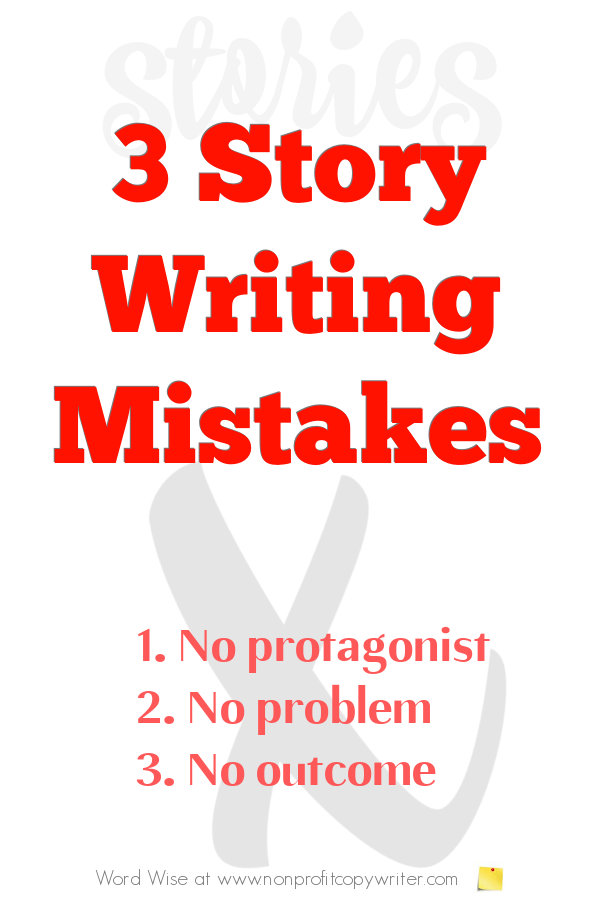
3 Story Writing Mistakes to Avoid (If You Want to Make a Point)
Award-winning writer Kathy Widenhouse has helped hundreds of nonprofits and writers produce successful content , with 750K+ views for her writing tutorials. She is the author of 9 books. See more of Kathy’s content here.
Updated 10.29.24
Writers use stories to make a point in a piece of content. One of the biggest story writing mistakes you can make is to use an example, rather than close the deal with a full-blooded story. Stories are the perfect opportunity to show, rather than tell.
But a story needn’t be complicated to make a point. “When we think of stories, it is often easy to convince ourselves that they have to be complex and detailed to be interesting,” says Leo Widrich, co-founder of social media management tool Buffer. “The truth is however, that the simpler a story, the more likely it will stick.”
How simple can you get?
There are just three elements a story must have. If you’re missing one of these, then you don’t have a story. You have an example or a scenario or an observation.
These three story writing mistakes are blunders of omission. That means they’re an easy fix. Make sure you include each of these elements in your stories … and you’ll make your point.
3 story writing mistakes to avoid (if you want to make a point)
Mistake #1: No protagonist
People like to read about other people. One of the more common story writing mistakes is the absence of a protagonist – or an unrelatable one. Your main character must be a person that the reader can identify with.
Let’s say you’re writing an article for a parenting publication. If you want your story to make a point, you won’t write about a hedge fund director who struggles to manage his investors’ emerging market expectations. Yes, you have a protagonist. But your readers can’t relate to him.
Instead, you can write a story that begins with, “It’s 8 PM – bedtime for Audrey Johnson’s four-year-old.”
Yay! You’ve fixed this story writing mistake! You have a main character named Audrey. The context tells us she is a parent, which means the publication’s readers can relate to her. And we also learn that Audrey has her child on a bedtime schedule.
Mistake #2: No problem
No problem? No story. People read content to solve their problems.
Further, a character with too many problems or generalized problems creates confusion for the reader. You need to specify the problem or conflict or challenge or issue. By whittling down to a particular problem, you simplify your content. Plus, you direct the reader to the point you will make.
Let’s go back to Audrey. You write, “Audrey Johnson has difficulty disciplining her four-year-old.” To which every parent would say, “No kidding. Disciplining is a 24/7 problem. Can you be more specific?”
So instead you try, “It’s 8 PM and Audrey Johnson cannot get her four-year-old to brush his teeth before bed. It’s a pattern that has repeated itself for a month in their Michigan home.”
You’ve fixed this story writing mistake. Audrey faces a specific problem: getting her preschooler to take care of bedtime tasks in a timely way. How many thousands of parents through the millennia can relate to Audrey right now?
Plus, the problem is not new. It’s been going on for a month. And it makes Audrey worried.
Mistake #3: No outcome
It’s one of the most common story mistakes you can make: no answer to the problem. No change. No solution.
Without an outcome, you simply paint a picture. To be fair, there’s a place for examples in content. Creating scenarios in content is a good way to connect with the reader.
But an example simply describes a scene. A story makes a point by showing change. If you want Audrey to show that she has experienced a type of transformation, you need to explain what happens next. You need to answer the question, “Now, what?”
“It’s 8 PM and Audrey Johnson cannot get her four-year-old to brush his teeth before bed. It’s a pattern that has repeated itself for a month in the Michigan home. But tonight, Audrey simply offers her son the two choices she learned from Choose and Go. And he’s off to bed.”
Hmm … something is different for Audrey. If I’m parenting a preschooler, I want to know more about Choose and Go. Don’t you? Audrey’s story shows there’s an answer to my problem. Transformation is possible. This story moves me into the next section of content.
A simple fix for your story writing mistakes
You’ve got a protagonist: the parent. You’ve got a problem: getting the preschooler to brush his teeth before bed. You’ve got an outcome: a parent who has made a change in how she disciplines – a change that gets results.
You’ve got the three pieces. You’ve got a story! Leave out any of them and you’ll have just an example.
An example paints a picture. Don’t mistake an example for a story.
A story makes a point by showing change.
More Storytelling Tips
Why You MUST Master Persuasive Storytelling ...
Why Telling Stories Sticks to Readers: It’s Science!
12 Places to Look for Story Writing Ideas ...
How to Write a Story to Make a Point ...
The Simple 5-Step Story Structure for Writing Quick Content Stories ...
Tips for getting stories from clients ...
More tips on our Writing Stories Pinterest board ...
Return from 3 Story Writing Mistakes to Nonprofit Copywriter home
As an Amazon Associate I earn from qualifying purchases.
Search This Site
Share This Page

Named to 2022 Writer's Digest list
BEST GENRE/NICHE WRITING WEBSITE


Stop Wasting Time!

Grab your exclusive FREE guide, "5 Simple Writing Tips You Can Put to Use in 10 Minutes or Less"









